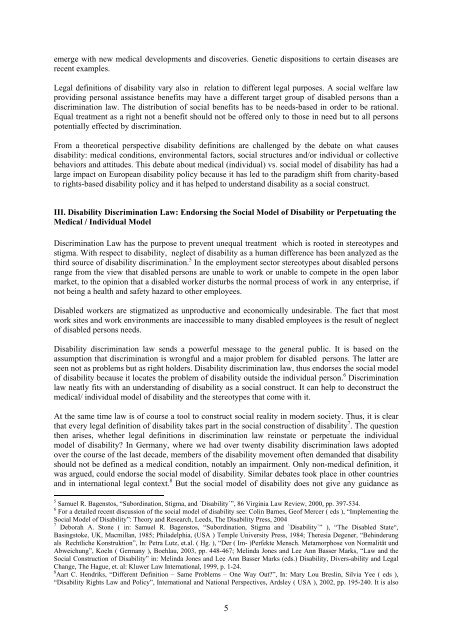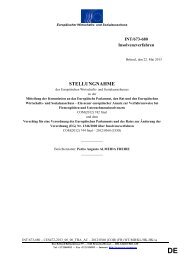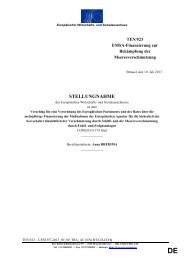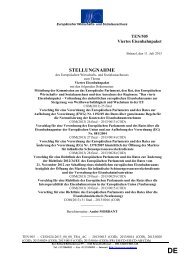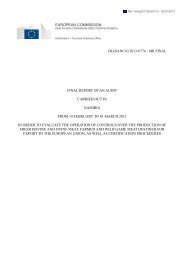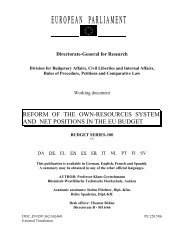Definition of disability
Definition of disability
Definition of disability
You also want an ePaper? Increase the reach of your titles
YUMPU automatically turns print PDFs into web optimized ePapers that Google loves.
emerge with new medical developments and discoveries. Genetic dispositions to certain diseases are<br />
recent examples.<br />
Legal definitions <strong>of</strong> <strong>disability</strong> vary also in relation to different legal purposes. A social welfare law<br />
providing personal assistance benefits may have a different target group <strong>of</strong> disabled persons than a<br />
discrimination law. The distribution <strong>of</strong> social benefits has to be needs-based in order to be rational.<br />
Equal treatment as a right not a benefit should not be <strong>of</strong>fered only to those in need but to all persons<br />
potentially effected by discrimination.<br />
From a theoretical perspective <strong>disability</strong> definitions are challenged by the debate on what causes<br />
<strong>disability</strong>: medical conditions, environmental factors, social structures and/or individual or collective<br />
behaviors and attitudes. This debate about medical (individual) vs. social model <strong>of</strong> <strong>disability</strong> has had a<br />
large impact on European <strong>disability</strong> policy because it has led to the paradigm shift from charity-based<br />
to rights-based <strong>disability</strong> policy and it has helped to understand <strong>disability</strong> as a social construct.<br />
III. Disability Discrimination Law: Endorsing the Social Model <strong>of</strong> Disability or Perpetuating the<br />
Medical / Individual Model<br />
Discrimination Law has the purpose to prevent unequal treatment which is rooted in stereotypes and<br />
stigma. With respect to <strong>disability</strong>, neglect <strong>of</strong> <strong>disability</strong> as a human difference has been analyzed as the<br />
third source <strong>of</strong> <strong>disability</strong> discrimination. 5 In the employment sector stereotypes about disabled persons<br />
range from the view that disabled persons are unable to work or unable to compete in the open labor<br />
market, to the opinion that a disabled worker disturbs the normal process <strong>of</strong> work in any enterprise, if<br />
not being a health and safety hazard to other employees.<br />
Disabled workers are stigmatized as unproductive and economically undesirable. The fact that most<br />
work sites and work environments are inaccessible to many disabled employees is the result <strong>of</strong> neglect<br />
<strong>of</strong> disabled persons needs.<br />
Disability discrimination law sends a powerful message to the general public. It is based on the<br />
assumption that discrimination is wrongful and a major problem for disabled persons. The latter are<br />
seen not as problems but as right holders. Disability discrimination law, thus endorses the social model<br />
<strong>of</strong> <strong>disability</strong> because it locates the problem <strong>of</strong> <strong>disability</strong> outside the individual person. 6 Discrimination<br />
law neatly fits with an understanding <strong>of</strong> <strong>disability</strong> as a social construct. It can help to deconstruct the<br />
medical/ individual model <strong>of</strong> <strong>disability</strong> and the stereotypes that come with it.<br />
At the same time law is <strong>of</strong> course a tool to construct social reality in modern society. Thus, it is clear<br />
that every legal definition <strong>of</strong> <strong>disability</strong> takes part in the social construction <strong>of</strong> <strong>disability</strong> 7 . The question<br />
then arises, whether legal definitions in discrimination law reinstate or perpetuate the individual<br />
model <strong>of</strong> <strong>disability</strong>? In Germany, where we had over twenty <strong>disability</strong> discrimination laws adopted<br />
over the course <strong>of</strong> the last decade, members <strong>of</strong> the <strong>disability</strong> movement <strong>of</strong>ten demanded that <strong>disability</strong><br />
should not be defined as a medical condition, notably an impairment. Only non-medical definition, it<br />
was argued, could endorse the social model <strong>of</strong> <strong>disability</strong>. Similar debates took place in other countries<br />
and in international legal context. 8 But the social model <strong>of</strong> <strong>disability</strong> does not give any guidance as<br />
5 Samuel R. Bagenstos, “Subordination, Stigma, and `Disability`”, 86 Virginia Law Review, 2000, pp. 397-534.<br />
6 For a detailed recent discussion <strong>of</strong> the social model <strong>of</strong> <strong>disability</strong> see: Colin Barnes, Ge<strong>of</strong> Mercer ( eds ), “Implementing the<br />
Social Model <strong>of</strong> Disability”: Theory and Research, Leeds, The Disability Press, 2004<br />
7 Deborah A. Stone ( in: Samuel R. Bagenstos, “Subordination, Stigma and `Disability`” ), “The Disabled State“,<br />
Basingstoke, UK, Macmillan, 1985; Philadelphia, (USA ) Temple University Press, 1984; Theresia Degener, “Behinderung<br />
als Rechtliche Konstruktion”, In: Petra Lutz, et.al. ( Hg. ), “Der ( Im- )Perfekte Mensch. Metamorphose von Normalität und<br />
Abweichung”, Koeln ( Germany ), Boehlau, 2003, pp. 448-467; Melinda Jones and Lee Ann Basser Marks, “Law and the<br />
Social Construction <strong>of</strong> Disability” in: Melinda Jones and Lee Ann Basser Marks (eds.) Disability, Divers-ability and Legal<br />
Change, The Hague, et. al: Kluwer Law International, 1999, p. 1-24.<br />
8 Aart C. Hendriks, “Different <strong>Definition</strong> – Same Problems – One Way Out?”, In: Mary Lou Breslin, Silvia Yee ( eds ),<br />
“Disability Rights Law and Policy”, International and National Perspectives, Ardsley ( USA ), 2002, pp. 195-240. It is also<br />
5


